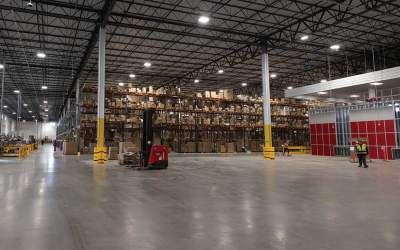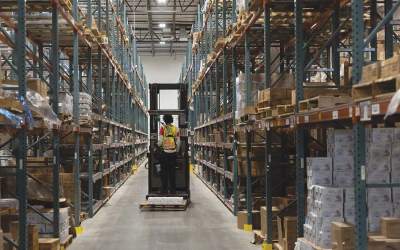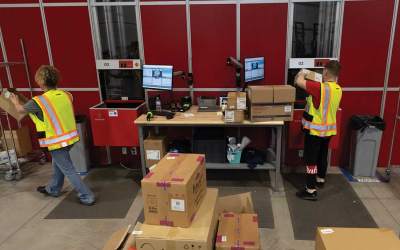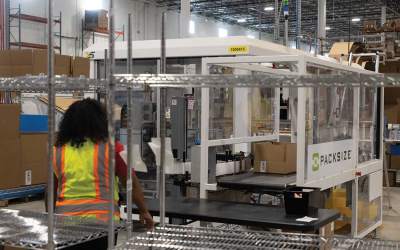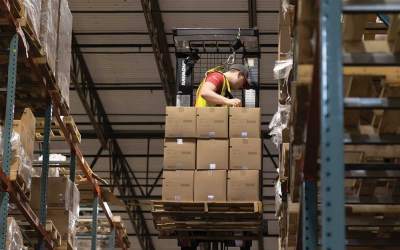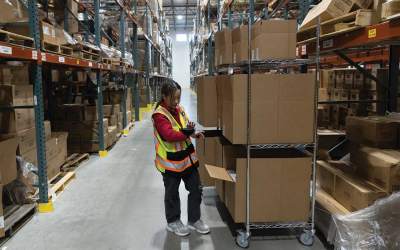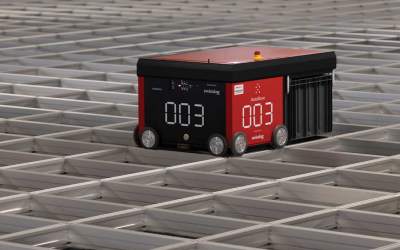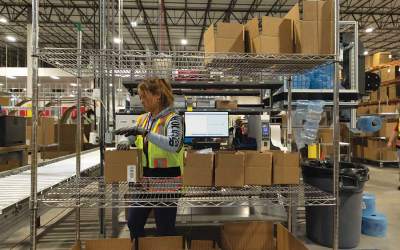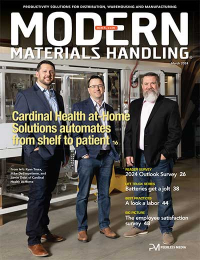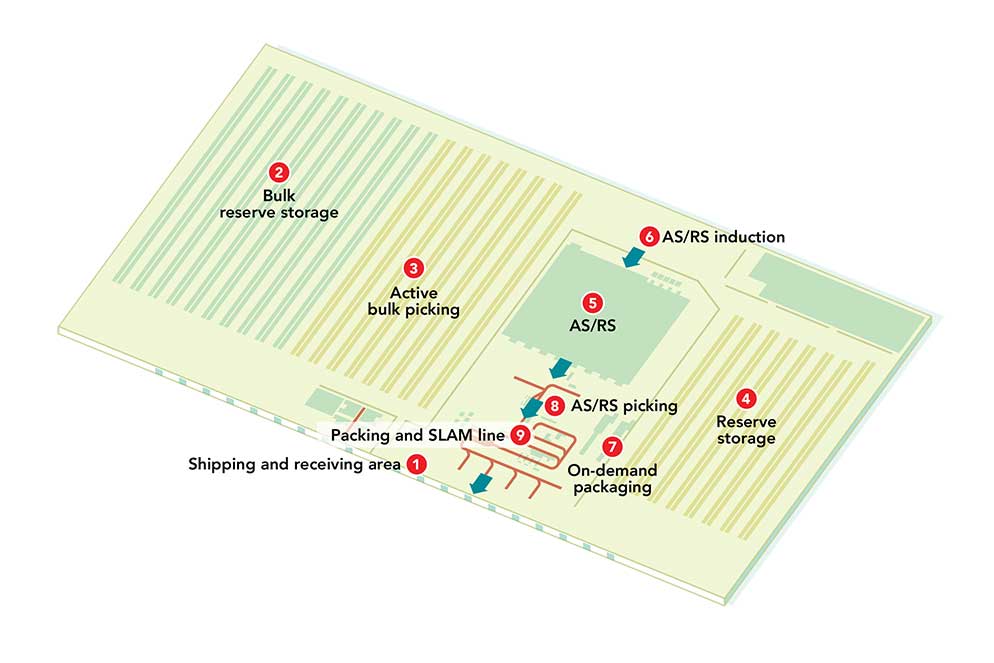Cardinal Health at-Home Solutions automates from shelf to patient
In a new Ohio DC, Cardinal Health at-Home Solutions is leaping into automation with on-demand packaging and robotic storage and picking. The result is a game-changer.
Eleven years ago, Cardinal Health acquired AssuraMed, a privately held provider of medical supplies to patients in their homes. Cardinal Health at-Home Solutions, the newly created division, allowed Cardinal Health to serve a growing population of aging and chronically ill patients at home after they left a clinical setting.
Since 2013, Cardinal Health at-Home Solutions developed a network of 10 strategically located distribution centers from the West Coast to the East Coast and points in between that can serve 99% of the U.S. population in one to two business days.
The newest facility, also the most automated in the network, is a 208,144-square-foot DC near Columbus, Ohio, that Jamie Deist, vice president of warehouse operations, says “sets the bar as our warehouse of the future. Grove City acts as a showcase location for customer visits to demonstrate our innovative approach to distribution.”
Shipping more than 3,400 packages a day, the facility represents Cardinal Health at-Home Solutions’ first foray into high levels of flexible automation. It features an automated packaging system (Packsize) that creates on-demand and customizable shipping boxes that reduce wasted packaging, along with a newly designed outbound scan, label, apply and manifest (SLAM) conveyor sortation system. But the centerpiece of the operation is a goods-to-person robotic picking solution (Swisslog and AutoStore). The heart and brain of the facility, the system currently has 40 bots, with room to expand, and 31,844 storage bins providing 83,000 cubic feet of storage for 14,154 SKUs.
“This is a game-changer for us, one that is going to improve our quality and get product from the shelves to patients faster than conventional operations,” notes Ryan Truax, director of operations.
While associates are picking 50 lines an hour in the startup phase of the project, “AutoStore will improve our pick rates threefold, with capacity to get up to 150 lines per hour,” Truax says. “We designed the system with the intention of allowing it to scale our operations dramatically.”
Cardinal Health at-Home Solutions describes its approach as “targeted automation,” with solutions designed to address specific business problems.
“One of the business challenges we targeted when designing our Grove City facility was that, due to our business growth, our existing distribution centers were nearing max capacity. With that in mind, we selected a facility footprint that would allow us to maximize space utilization and to plan for future increased inventory storage, AutoStore allows us to pick 60% to 70% of our inventory in a very compact place.” says Mike DeSimpelaere, vice president of network operations.
Meanwhile, right-sized packaging reduces the footprint of outbound shipments. DeSimpelaere adds that automation also improves the job satisfaction of associates who are no longer pushing a cart through the facility to pick orders.
On-time and accurate
If you have recently been hospitalized, filled a prescription at a pharmacy or visited the offices of a specialty physician, there’s a good chance you’ve interacted with Cardinal Health, the parent company of Cardinal Health at-Home Solutions. With more than 50 years of experience, it is one of the largest distributors of pharmaceuticals in the country, a global manufacturer and distributor of medical and laboratory products and a provider of performance and data solutions for healthcare facilities.
The company describes itself as “a crucial link between the clinical and operational sides of healthcare, delivering end-to-end solutions and data driven insights that advance healthcare and improve lives every day.” With headquarters in Dublin, Ohio, Cardinal Health serves nearly 90% of U.S. hospitals, more than 60,000 U.S. pharmacies and more than 10,000 specialty physician offices and clinics.
For much of its history, the company’s focus was on distribution to facilities. That changed in 2013 with the formation of Cardinal Health at-Home Solutions, which extended Cardinal Health’s reach into the homes of patients in need of care for chronic conditions like diabetes, kidney disease and sleep apnea, to name just a few.
Currently, the 10 existing facilities are shipping roughly 60,000 packages a day– an estimated 20 million packages a year to nearly 5 million customers. The network is one of the reasons Cardinal Health at-Home Solutions has more than tripled the number of customers served in 10 years. Plans are underway to open an 11th 350,000-square-foot facility in South Carolina in the summer of 2024.
While Cardinal Health at-Home Solutions is essentially a distribution business, what differentiates it is that it delivers medical supplies directly to patients’ homes, versus to a hospital, ambulatory surgical center or a doctor’s office.
Another differentiator is that a division of the at-Home Solutions business also operates as an e-commerce business. Patients place the bulk of their orders online, just as they would to any other e-commerce company. But, in the healthcare industry, the phrase “getting the right product in the right quantity to the right place at the right time” has a different criticality.
From a planning perspective, operations have some predictability as many customers are going to order the same products month in and month out. But that isn’t always the case.
“We are predictably unpredictable,” says Deist. “Our volume is the same from month to month, but there is variability within the week.”
Distribution centers experience the highest volumes early in the week; given same-day shipping service level agreements, that puts significant pressure on operations to process orders quickly to meet parcel carrier cutoff times regardless of the order volume that day.
“We forecast volumes at the monthly level, but the daily level is variable and unpredictable,” Deist says. Other variables are unexpected demand from new patients who have just been discharged from a medical facility.
Variability and aggressive service level agreements (SLAs) were significant drivers of the facility design as well as the shift from pick-to-cart to automation. Others included:
- the need to not only deliver on time but, given the criticality of the products, to eliminate errors and damage;
- the overall growth of the business;
- the tight labor market; and
- a changing product mix.
“Historically, we focused on small, fast-moving items that are easy to package and ship,” says Deist. “As our business has grown, we have added new categories like incontinence products that are bigger and bulkier. That has forced us to pick differently.”
Introducing automation
Cardinal Health at-Home Solutions typically begins plans for a new facility 24 months out, including the site delivery. “Our entire business model is built on transit time to our customers,” says DeSimpelaere. “When we grow and need more space in a geographic area, we begin to size the building to accommodate that growth.”
Plans for the Grove City facility got underway in late 2021. Several high-level goals led to the introduction of automation.
One was to reduce travel time so that people weren’t walking as much to complete a task. “We wanted to increase throughput and eliminate wasted effort,” DeSimpelaere says.
A second was to reduce wasted space; while Grove City is currently the largest facility in the network, the goal was to optimize that space. The AutoStore high-density solution minimized the footprint while maximizing the number of storage spaces. Related to that was the introduction of on-demand, right-sized packaging equipment to build shipping cartons based on the product going inside.
“The big difference between Cardinal Health and at-Home is packout and final shipment,” says Deist. “When the other sides of our distribution business are shipping to a hospital or a pharmacy, they’re shipping in returnable plastic totes. However, for at-Home Solutions, we’re shipping directly to patient doorsteps. So, we’re shipping in a corrugated package, and we’re using packaging equipment to size the shipping box to the order.”
A third was to lay out the building to create a flow between the automation and the conventional storage and picking areas for bulk products that can’t currently be handled by automation.
The fourth was to implement outbound automation to quickly convey and sort parcels from packing to shipping, where Cardinal Health at-Home Solutions works with multiple carriers.
Going into the design phase, the team investigated a number of solutions. “We want to use automation in a very targeted way,” says DeSimpelaere.
For instance, a conventional pick-to-conveyor solution offered speed, but because a conveyor is fixed, it doesn’t have the flexibility to adapt to future business changes. Autonomous mobile robots, or AMRs, reduced walking and wasted effort, but didn’t minimize the overall footprint. In most of the solutions on the market, you are limited in the number of totes that go on an AMR.
“In our other facilities, order selectors put 20 to 30 totes on a cart, so there’s a lot of pick density that we couldn’t get from an AMR,” DeSimpelaere says.
The combination of on-demand packaging and robotics goods-to-person picking addressed the most points on the wish list. Together, they delivered the storage, pick and shipping density that optimized the footprint of the building as well as outbound shipments.
The system provided the throughput needed to meet SLAs while increasing order accuracy. And, it checked the flexibility box: Cardinal Health at-Home Solutions is beginning with 40 bots, but the system can be expanded by adding more bots to the grid to get more throughput, and ultimately the grid can be expanded. The storage bins can be divided to accommodate new and different sized SKUs as the product mix changes.
The facility still uses pick carts with AutoStore to accommodate some shipping boxes that are too large for the conveyor system, says Truax. These larger cartons featuring license plate number (LPN) labels are scanned onto a rolling cart stationed at a picking port, which are rolled to packing once the pick is complete.
Two areas are for conventional storage and picking: In the reserve storage area, product is stored at the pallet level with active picking on the lower levels and storage above. The mixed cell area provides pallet and pallet flow rack and shelving storage for smaller, fast-moving items that aren’t a fit for automation, such as ostomy bags and urology supplies. In both areas, order selectors pick to carts, with a limited amount of pick to pallet in the reserve storage area.
The facility operates multiple shifts. Early in the day, an inbound team is focused on receiving and putaway; other teams create boxes in the on-demand packing areas. Later in the morning, order selectors begin filling orders up until cutoff time in the afternoon. Still later in the day, associates process anything not completed by earlier shifts.
Regardless of the shift, the on-demand packaging system creates boxes that are then assigned to carts for picking. Carts from the three areas are married together at packing, where they are automatically labeled before an associate adds dunnage and sends the cartons to the taping line. From there, they are sorted to the appropriate shipping lane.
Learning the system
Truax says there is a learning curve when you move from conventional operations to automated solutions. For one, Cardinal Health at-Home Solutions is working closely with Manhattan Associates to fine tune the warehouse management system (WMS) to account for a number of different picking scenarios; for instance, the same SKU might be picked as a case or an each if there are packs or boxes inside a case.
“We need to be able to go down to multiple different levels in a SKU based on how we purchase and sell an item,” he says.
They are also fine-tuning staffing levels to keep the automation and conventional areas “level loaded” throughout the day. And, they are learning how to determine the optimal min/max inventory levels within AutoStore.
“We are taking the analytics we’re getting from our warehouse execution system to balance fast movers that require a lot of bins and slow movers that require fewer bins,” Truax says.
However, as he noted earlier, the projected pick rates of 120 to 150 lines per hour “will be a game-changer for us.”
Now that Cardinal Health at-Home Solutions has begun an automation journey in earnest, it won’t stop here. The new facility planned for South Carolina will also feature on-demand packaging and robotic goods-to-person picking. The company is also nearly finished updating its WMS in its entire warehouse network. And, say DeSimpleaere and Deist, they are also investigating other technologies, such as pallet-handling automatic guided vehicles and shuttle systems for the reserve storage area.
“We are constantly working to research new technology, including automation, that will support improved service to our patients,” says DeSimpelaere.

Article Topics
AutoStore News & Resources
Forklifts Parts & Equipment deploying AutoStore solution to streamline fulfillment Cardinal Health at-Home Solutions automates from shelf to patient Pan Pacific Pet learns new trick GEODIS maximizes flexibility and minimizes touches DHL Supply Chain and AutoStore announce partnership expansion Robotics as a service (RaaS) catching fire Swisslog names Jens Schmale as new CEO effective start of 2024 More AutoStoreLatest in Materials Handling
Geek+ and System Teknik deploy PopPick solution for pharmacy group Med24.dk Beckhoff USA opens new office in Austin, Texas Manhattan Associates selects TeamViewer as partner for warehouse vision picking ASME Foundation wins grant for technical workforce development The (Not So) Secret Weapons: How Key Cabinets and Asset Management Lockers Are Changing Supply Chain Operations MODEX C-Suite Interview with Harold Vanasse: The perfect blend of automation and sustainability Consultant and industry leader John M. Hill passes on at age 86 More Materials HandlingAbout the Author
Subscribe to Materials Handling Magazine

Find out what the world's most innovative companies are doing to improve productivity in their plants and distribution centers.
Start your FREE subscription today.
April 2024 Modern Materials Handling

Latest Resources


